Ryburgh Railway Station Staff in the 1940’s.
I have recently been in email contact with former villager Alan Bloomfield who sent me some recollections of life in the village during WW2. His father was a Porter/Signalman at Ryburgh Station and the family lived at the Station Cottages on the Fakenham Road. He kindly sent me the photograph below with some notes on the people depicted:
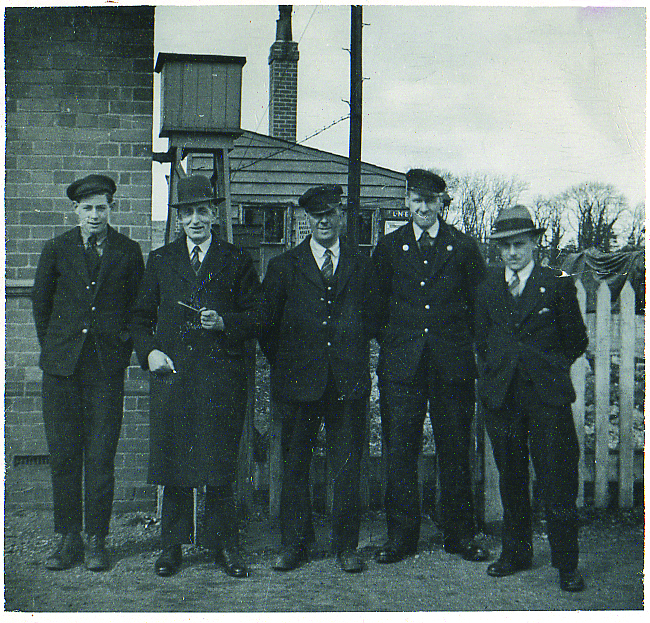
From left to right:
Ralph Geary (Junior Porter), Reginald (Reggie) Dunnett (Station Master - Ryburgh & County School), Victor (Dilly) Artherton & Harold Bloomfield (both Porter Signalman) & an unknown visiting Inspector.
Alan writes:
“Ralph Geary’s family lived in the top Council Houses. His father, Bill, worked for the GPO as a telegraph pole/lineman in one of those large green vans that usually had a telegraph pole poking out of it above the cab.
Ralph kept a nanny goat on the nearby railway embankment. He milked this and could direct the milk stream directly into the mouth of the Station cat! Ralph married Mary Gibson, whose father, Donald, was Horseman, later Farm Foreman at Hill Farm (Mitchell’s Farm), Little Ryburgh which a Ernest Platten farmed.
**************
Reginald & Mrs Dunnet lived in the Station House and didn’t have any children. Mrs Dunnet was an avid gardener. As many will know the original Ryburgh Station Building was bombed in 1941. A low cost wooden Station Booking Office & Waiting Room was erected north of the original building. A garden was created in the foundations of the original Station building which was developed and maintained by Mrs Dunnett. She also maintained the small garden opposite Station House adjacent to ‘the Shop’ part of Station Cottages. Railway Stations were judged annually by LNER (later BR). Ryburgh Station won a number of first prizes largely due to the efforts of Mrs Dunnett.”
The certificate below has survived in the museum at Gressenhall:
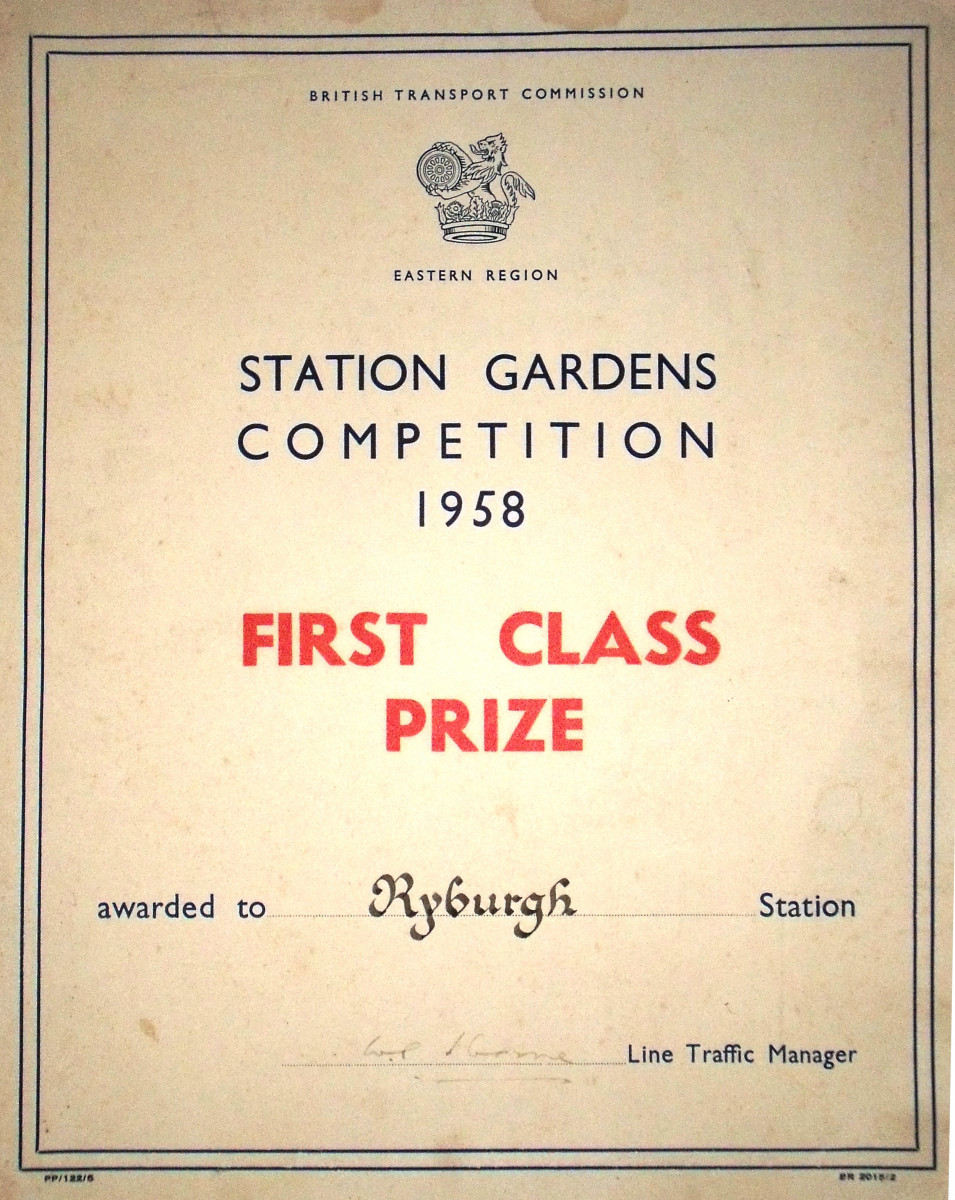
The “shop” next to the Station House, was for many years a Coffee Tavern. These institutions were a practical part of the Temperance Movement and was promoted in Ryburgh by Revd. Geoge Tatham and William Penn Esq. from Sennowe.
Dereham and Fakenham Times Dec 11th 1880:
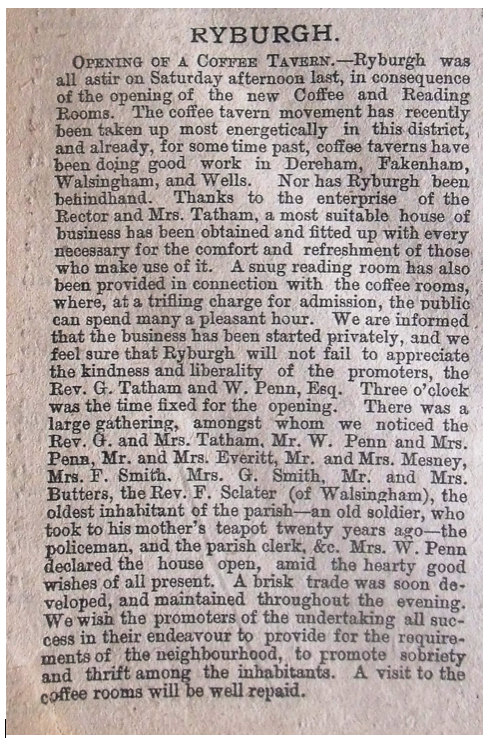
“The Alexandra Coffee Rooms“ were run by Mrs Emily Turner the widow of a railway platelayer, Marshall Turner. They were married at Burnham Thorpe in April 1881. Marshall died in 1886 leaving her with two daughters. It is very possibly the railway community brought her to the village. Quite when she/they came to Ryburgh isn’t clear because the Coffee Tavern as we see above, was already up and running but it is probably after she was widowed. She was certainly resident and the proprietor in 1891. Their younger daughter was born in South Wales in 1886 after Marshall had died. She was the sister of Charles Dawson who was a Ryburgh signalman in 1901 and also lived there at the house. Emily died in 1915 both daughters were unmarried at the time. The shop front can just be seen in this postcard view set back a little between Station Cottages and the Station Master's House:
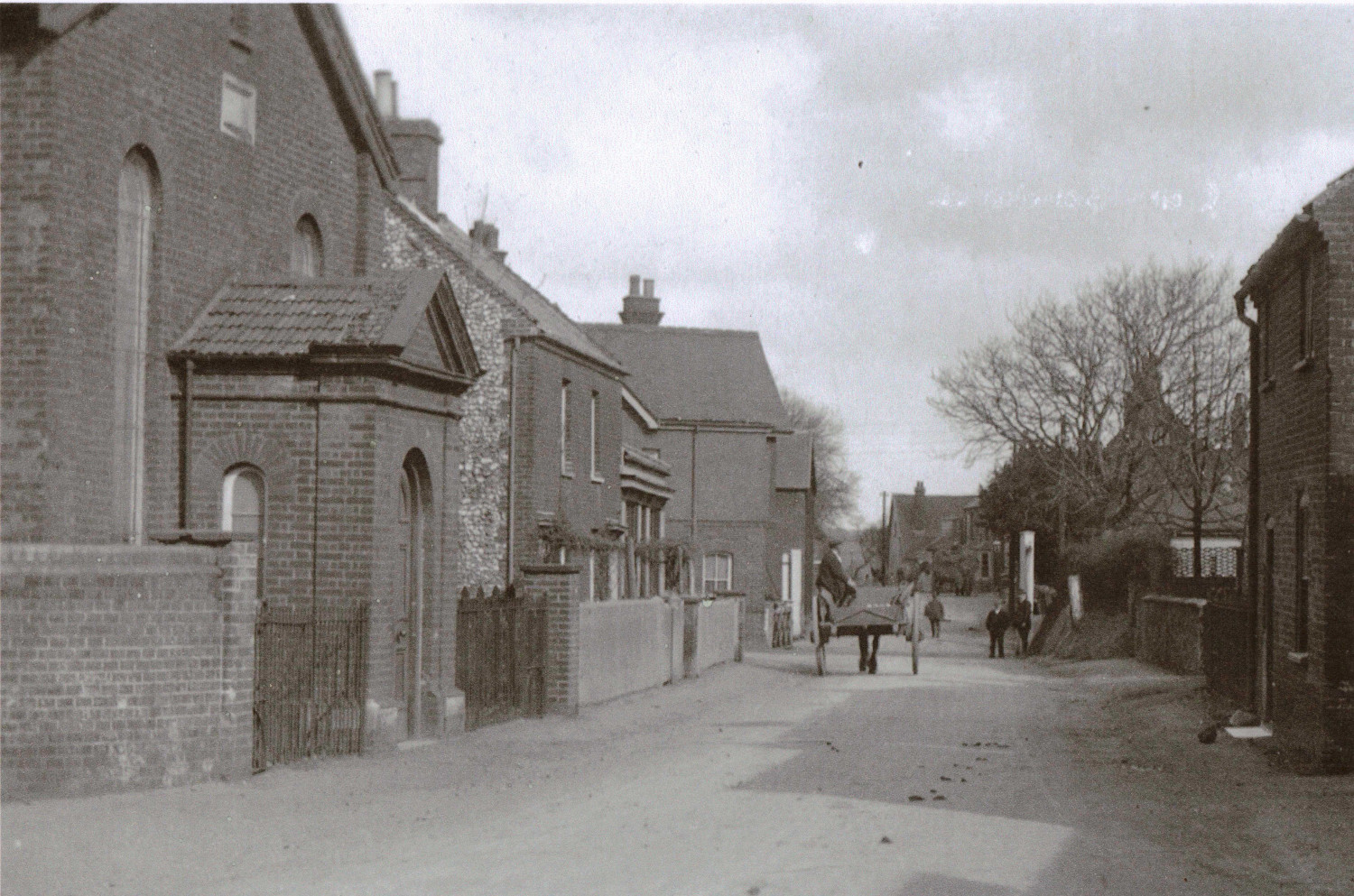
**************
Alan continues:
“Victor Artherton (known as ‘Dilly’) and his family lived in one of the two-bedroom semi-detached Station Cottages, the far end, away from the shop next to our family the Bloomfields. Vic suffered a bad knee injury, when playing football as a young man, which was to plague him for the rest of his life. Despite this, Vic and his Wife ‘Mimmy’ had a family of four - Maurice, Michael & Margaret and Maureen. Vic was very hard working. To supplement his income with a growing family he worked very hard with ‘Blarney’ Neale, the coal merchant, emptying rail coal deliveries into the siding coal building (now part of the Granary housing), bagging up the coal, loading the coal lorry and delivering coal to the residents of Ryburgh, Stibbard & elsewhere.
This image of the Coal shed on the end of the Granary building dates from 1963 and is entitled “The last day of the railway”:
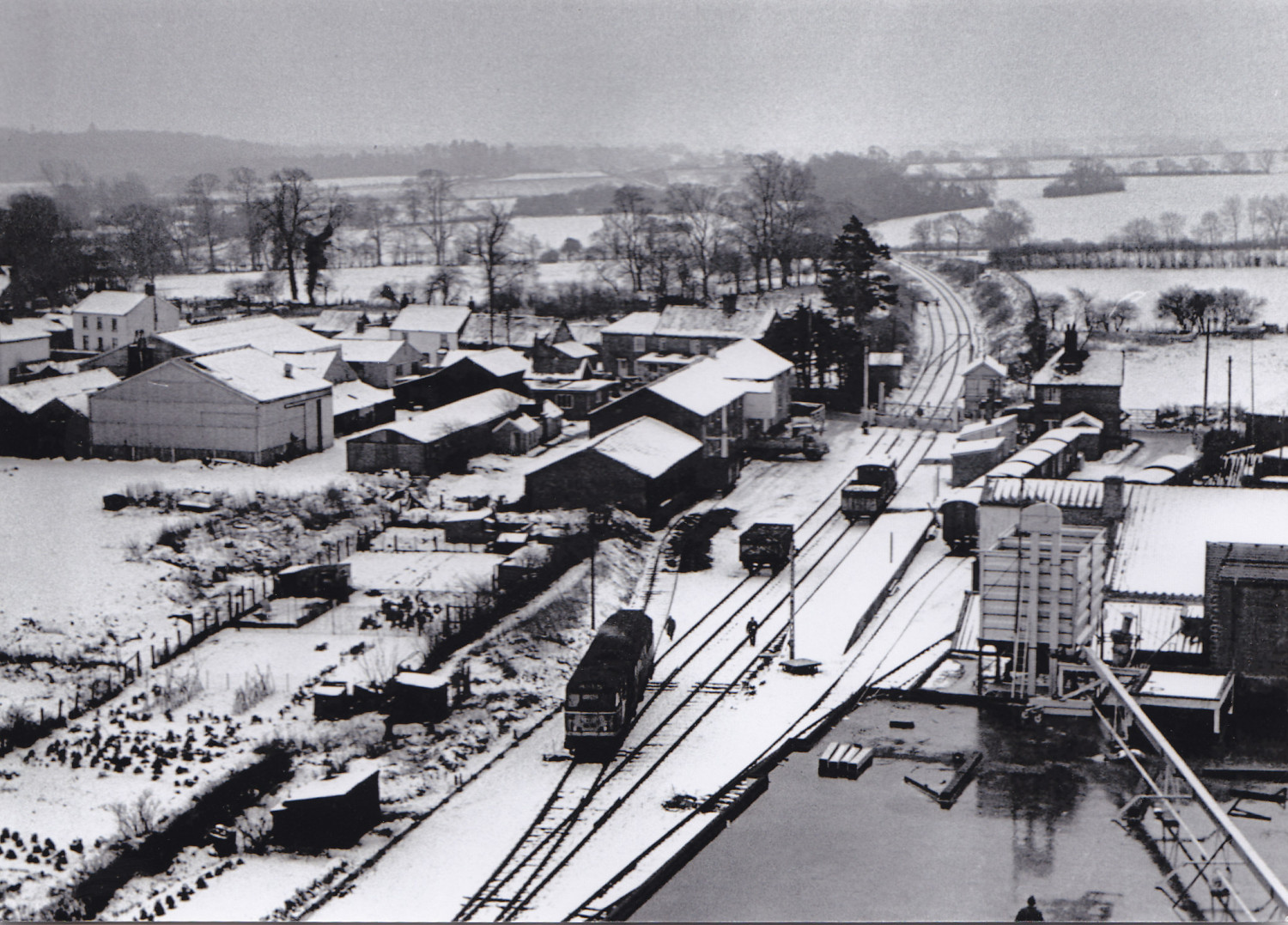
I particularly remember being with them both on a Stibbard coal delivery stopping for a ‘refreshment’ at Jessie Bunn’s ‘Ordnance Arms’. Vic was also ‘Greenkeeper’ at the ‘Crown’.
One occurrence, worth repeating, was a Saturday night around 10 o’clock or so when loud & repeated train whistles were heard from the railway line. Then, the door from the ‘Crown’ banged and Vic could be heard hopping as fast as he could down the road to the crossing, opening the gates and signalling for the train to enter the station with a very annoyed engine driver and guard! What had happened was that, against railway regulations, the last train of the day, from County School, had been allowed to proceed to Ryburgh (under caution) without being accepted by the Ryburgh Signalman who was competing and finishing an important darts match!
Sons Maurice and Michael joined the railway. Maurice as a Signalman and Michael as a Platelayer (maintaining the track). Margaret (who we all know) worked in Fuller’s Station Shop (the Top Shop and now no more) whilst Maureen married young and moved to the Peterborough area. Michael was a talented footballer and, ironically, suffered a bad leg fracture which, similarly to his Father, made walking difficult for the rest of his life.
The Arthertons moved, with great relief, to the ‘new’ Council houses at Hillcrest when they were built in the late 1940’s. Joe & Teresa Hamblin nee Nelson were our new neighbours.
Harold and Madge Bloomfield (Alan’s father & mother), moved from Lowestoft to Station Cottages (No 6 Fakenham Road) next to the Artherton family in 1938 or so. I was born in 1941 with brothers John & David born in 1945 & 1946. The family were fortunate to be able to make full use of ‘the Shop’, adjacent to the house on the Station side, as a third bedroom. Father was Porter Signalman at Ryburgh until being promoted to Signalman at Fakenham East around 1950. This necessitated him cycling to and from Fakenham beside the railway line, a journey of 2.5 miles instead of almost double that by road.
Father was also Church Warden with Jack Watson of Winter’s Farm Gateley, whilst my Mother was a member of the Village Woman’s Institute. Both were members of St Andrew’s Church where my Father and brothers all served at the Altar as Acolytes. I couldn’t or wouldn’t stand the incense! Rev Geoffrey Ford was the Rector then having replaced the Rev. Tatham who had died in January 1947.
These were good days in a small village where you knew almost everyone. Travel at this time being a bicycle or you walked or took the train. Very few motor cars and a very occasional bus on market day.”
More from Alan
This story was originall submitted to the BBC People’s War site by Wymondham Learning Centre on behalf of the authors, Madge and Harold Bloomfield and has been added to this site with Alan's permission.
Bomb One:
In 1942 we lived in a railway house by the side of the railway line near The Maltings in Great Ryburgh. We kept chickens in our garden and they lived in a very smart Bolton & Paul chicken hut that had four wheels.
One night a bomb dropped on the railway line (it was meant for the Maltings) and we rushed out to see what damage had been done. To our horror all that was left of the Bolton & Paul chicken hut was the four wheels and the chickens had lost all their feathers. Fortunately the chickens survived and grew new feathers.
Bomb Two: August 1942.
A very good friend of mine (the policeman’s wife) was ill in bed and the doctor prescribed pearl barley water for her, which I went to collect from my mother-in-law. As a result I was late home to bath my baby Alan, nine months old, who was usually in bed by six p.m. I undressed my baby to bath him and he was lying on his mat when my husband, Harold, said, “That sounds like a German plane flying very low — quickly get in the corner of the kitchen.”
I wrapped Alan in a blanket and rushed to the side of the kitchen and Harold bent down over us. Suddenly there was a huge blast and the windows of our house were blown out and doors blown off into the road. There was broken china and glass everywhere — just chaos. A policeman arrived and told me to take Alan to my mother-in-law who lived nearby. When I returned home the firemen were there with an appliance as there was a fire in the roof. The firemen told us to salvage everything we could from upstairs. I remember emptying my wardrobe (including my Sunday best clothes) and wrapping them all in a sheet and throwing them out of the window. I vowed never to keep clothes for Sunday best again. My eyes then fell upon Alan’s cot which was full of tiles and bricks and I realised that if it had not been for megetting the pearl barley for my friend, thus being late in putting Alan to bed, he would have been killed.
We stayed in our home, which had cardboard for the windows and the doors hung in a makeshift way. I was upset that the Chapel was repaired before my house since I felt that people should have been put first.
After that, when the siren sounded I was very nervous about staying in the house and always put my baby in the pram and went to my mother-in-law’s. I felt unhappy living in our house and when I heard the siren I felt that the German planes were coming to get me.
Bomb Three:
Eventually an incendiary bomb was dropped on the Maltings. The firemen were called and put water on the building. This resulted in the malt swelling and in places the walls of the Maltings were pushed out. Later the Maltings were repaired.
.